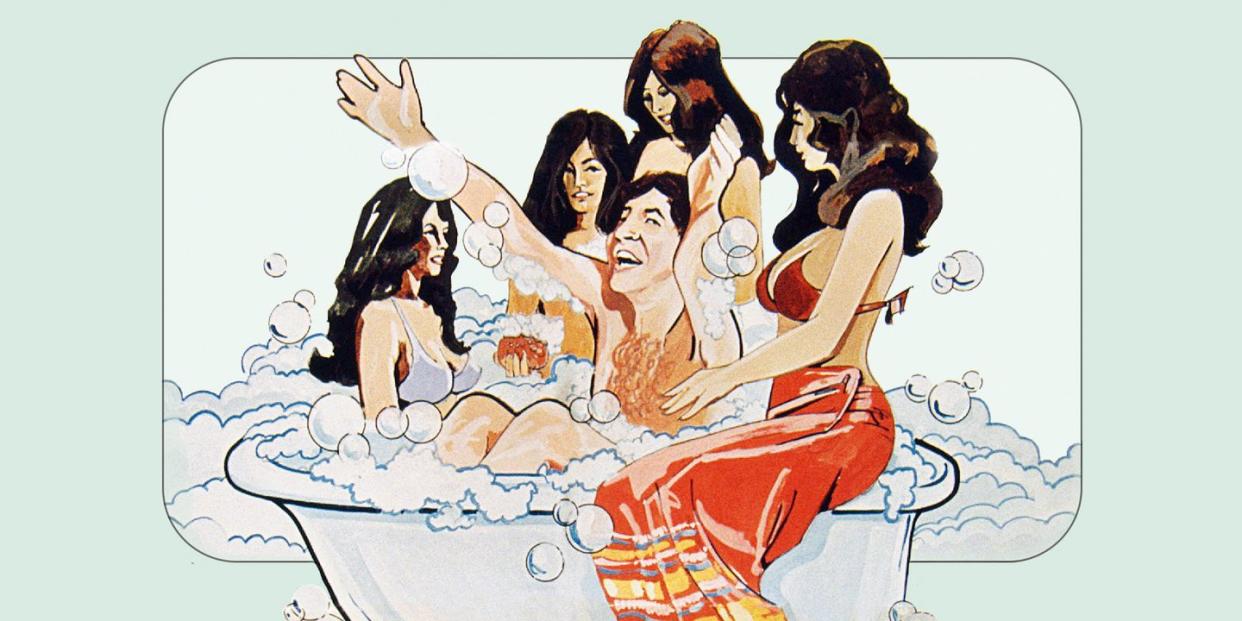'Minx' Is A Work of Fiction, But the Porn Valley Was a Real Place

Episode Three of Minx, HBO Max’s raunch-com about the first erotic magazine for women, opens with a photographer encouraging an editor to stuff film negatives inside her bra. Bottom Dollar Publications, the low-rent publisher of magazines like Randy Republicans and Secretary Secrets, receives a surprise visit from the feds, who make off with everything the staff members can’t hide on their person. If no one seems alarmed, that’s because it’s not their first police raid—actually, it’s their nineteenth. “Every time they come in, it’s for something else,” the photographer explains. “A zoning violation, harboring a felon—the charges are always bullshit. This is just a racket. A shakedown.”
Minx is a work of fiction, but its story unfolds against the very real landscape of the booming 1970s Los Angeles pornography industry. Back then, the business experienced a veritable gold rush—so much so that the San Fernando Valley became the home of what’s since become a multibillion dollar industry, earning it nicknames like Porn Valley, San Pornando Valley, and Silicone Valley. Adult filmmakers were lured to the Valley by low-rent industrial spaces and access to the mainstream movie industry, as well as its pool of attractive young talent looking to make quick cash. As a result of those fertile conditions, Porn Valley exploded, employing between 10,000 and 20,000 people every year, and raking in as much as $11 billion in annual sales. According to the HBO documentary series Pornucopia, at one time, nearly 90% of all legally distributed pornography in the United States was filmed or produced by studios based in the San Fernando Valley. The scene was immortalized in Paul Thomas Anderson's Boogie Nights.
But not everyone was on board. The industry faced challenges from politicians, mainstream business leaders, and concerned citizens, all of whom accused porn professionals of lending a seedy characterization to the desert suburb. Minx gestures at this in the introduction of Bridget Westbury, the San Fernando Valley’s new conservative city councilwoman, who’s bound and determined to clean up the region’s act. When Doug Renetti, Bottom Dollar’s owner, pays a visit to her office and learns of her plans, he asks, “What are you trying to do here—cut out the Valley’s heart?” The councilwoman retorts, “Or its tumor!” From randy bookstores to erotic magazine-makers to film studios, none of these businesses were illegal, but opponents still found ways to fabricate a real threat. “The LAPD often confiscated equipment from porn sets,” recalls legendary porn star Nina Hartley, “and they would even arrest people working in the industry and charge them with prostitution.”
Porn Valley took a hit in the 1980s, when Ronald Reagan and the conservative movement put pressure on the industry. In 1985, Reagan convened a Presidential Commission on Pornography; in 1987, he unveiled legislation intended to combat obscenity, warning adult filmmakers, “Your industry’s days are numbered.” Paul Pearlman, a former producer of underground porn working out of the Valley, remembers the time well. “We struggled,” he said. “It wasn’t necessarily difficult in the sense that we were suddenly broke, but it was this sudden shift in [American] values, and we were the first victims.”
But by the end of the 1980s, Porn Valley was once again aloft, as the popularization of VHS technology provided a welcome shot in the arm. Consumers could now rent a porno and watch it alone in the privacy of their own homes, rather than covertly buy tickets to an adult theater and hope not to run into anyone they knew. With Reagan out of the White House, conditions were once again friendly, and into the 1990s, business boomed anew. The affordability of handheld cameras reduced barriers to entry, and for the first time in history, the Internet was beaming adult content straight into consumers’ homes. When feature filmmaking plummeted by 13% in 1999, as mainstream studios shipped production abroad to cut costs, adult filmmaking rose by 25%.
In the last decade, Porn Valley has once again experienced a downturn. A massive sea change occurred in 2012, when a new law requiring porn actors to wear condoms on camera took effect, resulting in an enormous exodus. The industry by and large fled to Las Vegas, resulting in a 95% drop in adult video permits filed that year. In 2016, the law was overturned, which porn industry leaders argued would bring business back to the Valley. "Production out-of-state is a pain in the butt," said Adam Grayson, chief financial officer at Evil Angel, a maker and distributor of adult films. "You’ve got to buy a lot of Southwest Airlines tickets. People would love to come back here."

So what’s next for Porn Valley? The adult entertainment industry writ large faces an existential crisis brought on by the complete saturation of digital porn: how can filmmakers inspire consumers to pay for something free and widely available? Obscenity challenges from lawmakers have largely dried up, but now, the call is coming from inside the house, as women in the porn industry speak out about the abuse they’ve suffered on these film sets, and about the need to create adult entertainment by and for viewers who aren’t white cis-het men.
Whether Porn Valley can reinvent itself once again remains to be seen, but don’t count them out just yet. Even when the Valley has been down, somehow, they’ve always come back. “The most notable works typically come out of the Valley,” said Alec Helmy, president and publisher of XBIZ.com, which reports on the adult entertainment industry. “It’s still the hub, no matter what people say. It’s still Porn Valley.”
You Might Also Like
